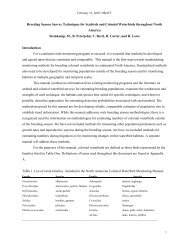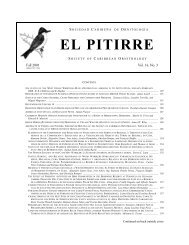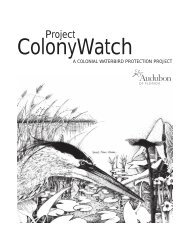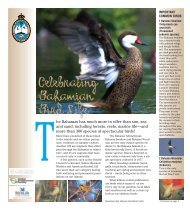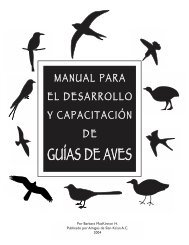body draft - Society for the Conservation and Study of Caribbean Birds
body draft - Society for the Conservation and Study of Caribbean Birds
body draft - Society for the Conservation and Study of Caribbean Birds
- No tags were found...
You also want an ePaper? Increase the reach of your titles
YUMPU automatically turns print PDFs into web optimized ePapers that Google loves.
NEW NATURE TOURISM INITIATIVE ON CAYMAN BRACPATRICIA E BRADLEYNature Tourism Consultant to Cayman Brac, Cayman Isl<strong>and</strong>AWARE THAT NATURE TOURISM had become <strong>the</strong>fastest growing branch <strong>of</strong> <strong>the</strong> industry in <strong>the</strong> <strong>Caribbean</strong>,in 1998, <strong>the</strong> Cayman Isl<strong>and</strong>s Government decidedto develop a l<strong>and</strong>-based initiative on CaymanBrac. The project has been designed to be <strong>of</strong> lowimpacton <strong>the</strong> small population <strong>of</strong> 1600 Brackers,who retain <strong>the</strong>ir flourishing cultural <strong>and</strong> architecturalheritage, <strong>and</strong> on <strong>the</strong> relatively unspoiled natural <strong>for</strong>ests<strong>and</strong> wildlife. In <strong>the</strong> first phase, completed in December2000, some 35 “heritage sites” were chosento show <strong>the</strong> most representative natural features <strong>of</strong><strong>the</strong> Brac; all are described in an illustrated brochuremap<strong>and</strong> identified by roadside location <strong>and</strong> interpretativesigns. Six large h<strong>and</strong>-painted porcelain panels,placed at <strong>the</strong> most visited locations, describe <strong>the</strong> lifehistories <strong>of</strong> birds, faunal biodiversity, <strong>and</strong> wetl<strong>and</strong>secology. Aimed at hikers, naturalists, bird watchers,botanists <strong>and</strong> photographers, <strong>the</strong> majority <strong>of</strong> heritagesites are old trails <strong>and</strong> walks along wetl<strong>and</strong>s, shores,marine cliffs, <strong>and</strong> through endemic <strong>for</strong>ests. As well,several large caves with deep chambers are listedtoge<strong>the</strong>r with those used as historic <strong>and</strong> modern hurricaneshelters. Caves that house owls <strong>and</strong> <strong>the</strong> mainbat colonies have been left <strong>of</strong>f <strong>the</strong> map.As in many o<strong>the</strong>r West Indian isl<strong>and</strong>s, nature tourismis seen as a way <strong>of</strong> <strong>of</strong>fering some protection <strong>for</strong><strong>the</strong> natural resources <strong>and</strong> biodiversity <strong>of</strong> CaymanBrac (where <strong>the</strong>re are no protected wetl<strong>and</strong>s <strong>and</strong> only180 acres <strong>of</strong> protected <strong>for</strong>est) by giving <strong>the</strong>m a dollarvalue as nature tourist attractions. L<strong>and</strong> prices skyrocketedin <strong>the</strong> Brac in <strong>the</strong> late 1990s <strong>and</strong> it is nowtoo expensive <strong>for</strong> <strong>the</strong> National Trust to purchase l<strong>and</strong><strong>for</strong> conservation. Low impact tourism is feasible on<strong>the</strong> Brac because <strong>of</strong> <strong>the</strong> small resident population,only 400 tourist rooms, no cruise ship visits, <strong>and</strong>about 70% <strong>of</strong> l<strong>and</strong> area covered by <strong>for</strong>est <strong>and</strong> shrubl<strong>and</strong>.Marketing is being directed at tourists in <strong>the</strong>higher income bracket, who require peace <strong>and</strong> tranquilityin unspoiled, safe natural surroundings where<strong>the</strong>y can be self-guided; organized tours <strong>and</strong> nightlifeare not a feature <strong>of</strong> <strong>the</strong> Brac! Never<strong>the</strong>less, we areaware <strong>of</strong> <strong>the</strong> dangers to <strong>the</strong> isl<strong>and</strong>’s biodiversity―thatthis was how many eco-tourist destinationsbegan, later to be spoiled by <strong>the</strong>ir success, withGr<strong>and</strong> Cayman a case in point. But <strong>the</strong>re is also aneed to keep <strong>the</strong> Brac sustainable <strong>for</strong> <strong>the</strong> people, aswell as <strong>the</strong> wildlife, <strong>and</strong> jobs must be created <strong>for</strong> <strong>the</strong>young to prevent <strong>the</strong>m leaving <strong>the</strong> isl<strong>and</strong>. Thus, weare putting our <strong>for</strong>ests, wetl<strong>and</strong>s, fauna, <strong>and</strong> flora towork. As a corollary, <strong>the</strong> goals <strong>of</strong> this initiative (i.e.,sustainable development) have been incorporatedinto <strong>the</strong> schools’ curricula, along with a wetl<strong>and</strong>secology unit devised by <strong>the</strong> West Indian Whistling-Duck Working Group. The teachers are enthusiasticallyorganizing field trips, <strong>and</strong> <strong>the</strong> walks <strong>and</strong> trailsclose to <strong>the</strong> schools are being used as a natural laboratory.It is hoped that by <strong>the</strong>se early education <strong>and</strong>awareness programs <strong>the</strong> younger generation will developan underst<strong>and</strong>ing that <strong>the</strong> natural world on <strong>the</strong>Brac has its own intrinsic <strong>and</strong> cultural value.The topography <strong>of</strong> Cayman Brac is dominated bya central limestone plateau know as “The Bluff,”which is flanked by narrow coastal plains to <strong>the</strong>north <strong>and</strong> south. Be<strong>for</strong>e roads were developed, <strong>the</strong>only access between <strong>the</strong> north <strong>and</strong> south coasts wasby a series <strong>of</strong> footpaths across <strong>the</strong> Bluff. By <strong>the</strong> end<strong>of</strong> <strong>the</strong> 20th century, only a few footpaths remained,because most had been turned into roads or incorporatedinto building sites. Fortunately, six footpathshave been secured as public rights-<strong>of</strong>- way. Theymake superb hiking trails with surfaces upgraded <strong>for</strong>safer walking <strong>and</strong> a series <strong>of</strong> steps constructed up <strong>the</strong>face <strong>of</strong> <strong>the</strong> bluff to allow access from <strong>the</strong> north coast.Five <strong>of</strong> <strong>the</strong> trails pass through endemic tropical <strong>for</strong>est<strong>and</strong> are excellent places <strong>for</strong> all types <strong>of</strong> naturalists,especially bird watchers, butterfly experts, <strong>and</strong> botanists.The Brac parrot is our flagship species, protectedwith a 180-acre breeding reserve, but also o<strong>for</strong>nithological interest are <strong>the</strong> endemic races <strong>of</strong> <strong>the</strong>Vitelline Warbler, Thick-billed Vireo, <strong>and</strong> <strong>the</strong> RedleggedThrush. Over 180 species <strong>of</strong> birds have beenrecorded on <strong>the</strong> Brac, 79% <strong>of</strong> which are NorthAmerican migrants, <strong>and</strong> most are surprisingly approachableallowing good nature photography.Boardwalks have been built on <strong>the</strong> small wetl<strong>and</strong>s in<strong>the</strong> southwest, close to <strong>the</strong> tourist hotels, <strong>and</strong> ano<strong>the</strong>rwetl<strong>and</strong> is being restored following it stint as <strong>the</strong>public dump. Whereas to date only a lagoon <strong>and</strong> <strong>the</strong>Parrot Reserve are protected areas, a Brac family has<strong>of</strong>fered <strong>the</strong> National Trust l<strong>and</strong> that contains <strong>the</strong> onlyheronry on <strong>the</strong> isl<strong>and</strong>. O<strong>the</strong>r sites (e.g., <strong>the</strong> <strong>for</strong>est onei<strong>the</strong>r side <strong>of</strong> <strong>the</strong> hiking trails) are dependant on <strong>the</strong>El Pitirre 14(1) Page 35




